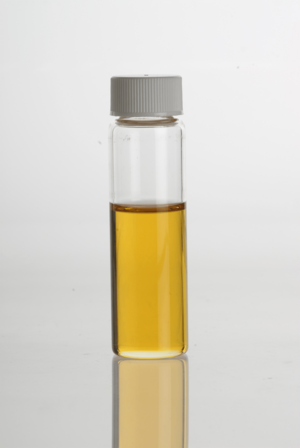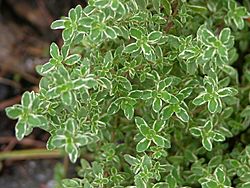Thyme facts for kids

A bundle of thyme
|
|||||||
| 101 kcal (423 kJ) | |||||||
|
|||||||
Thyme is a popular herb that comes from certain plants in the Thymus family. These plants are known for their strong smell and stay green all year round. They belong to the Lamiaceae family, which also includes mint. Thyme plants are related to oregano and mostly grow naturally around the Mediterranean region. People use thyme for cooking, for health reasons, and even as pretty garden plants. The most common type grown for cooking is called Thymus vulgaris.
Contents
History of Thyme
Thyme first grew in the Mediterranean region. It might have been first grown by people in the Levant area. Ancient Egyptians used thyme to help preserve bodies. The ancient Greeks put thyme in their baths. They also burned it as incense in their temples. They believed thyme gave people courage.
The Romans helped spread thyme across Europe. They used it to make their rooms smell clean. They also added it to cheese and drinks for flavor. In the European Middle Ages, people put thyme under their pillows. They thought it would help them sleep and stop bad dreams. Women often gave thyme leaves to knights and warriors. They believed it would make them brave. Thyme was also burned as incense at funerals. People thought it would help souls move to the next life.
The name of a type of fish, Thymallus, comes from thyme. This fish, like the grayling, has a faint smell of thyme.
Growing Thyme
Thyme grows best in a warm, sunny spot. It needs soil that drains water well. You usually plant thyme in the spring. After that, it grows back every year. You can grow new thyme plants from seeds, by taking small pieces (cuttings), or by dividing parts of an older plant. Thyme can handle dry weather very well. It can also survive very cold temperatures. You can find it growing wild on high mountains. It grows well on dry hillsides. After it flowers, you can trim it. This stops the plant from becoming too woody.
How Thyme is Used in Cooking
In some countries in the Levant, there is a spice mix called za'atar. This mix often contains many of the natural oils found in thyme. Thyme is also a common part of a French herb bundle called bouquet garni. It is also found in herbes de Provence.
You can buy thyme fresh or dried. Fresh thyme has more flavor. It is usually available all year from greenhouses. Fresh thyme does not last long, usually about a week. But you can freeze it carefully to make it last for months.
Fresh thyme is often sold in bunches of sprigs. A sprig is a single stem from the plant. It has a woody stem with leaves or flowers. These are spaced about 1 to 2.5 centimeters apart. A recipe might ask for a bunch of thyme, a few sprigs, or a certain amount in tablespoons or teaspoons. Dried thyme is widely used in Armenia to make herbal teas.
Sometimes, you use the whole sprig of thyme. This is common in a bouquet garni. Other times, you remove the leaves from the stem and throw the stem away. If a recipe says "bunch" or "sprig," it usually means the whole plant part. If it says "spoons," it means just the leaves. It is fine to use dried thyme instead of fresh thyme.
You can remove the leaves from the stems in a few ways. You can scrape them off with the back of a knife. Or you can pull them off using your fingers or a fork. Thyme keeps its flavor well when it is dried. This is better than many other herbs.
Thyme's Health Benefits
Oil of thyme is an essential oil from common thyme (Thymus vulgaris). This oil contains a lot of a substance called thymol. Thymol makes up about 20–54% of the oil. Thyme essential oil also has other compounds. These include p-cymene, myrcene, borneol, and linalool.
Thymol is a type of antiseptic. This means it helps stop the growth of germs. It is an active ingredient in many mouthwashes, like Listerine. A long time ago, before we had modern antibiotics, oil of thyme was used to treat bandages.
Important Types of Thyme
- Thymus citriodorus: This type includes lemon, orange, and lime thymes. They have a citrusy smell.
- Thymus herba-barona (caraway thyme): This thyme is used in cooking and as a ground cover. It has a very strong smell like caraway seeds.
- Thymus praecox (mother of thyme, wild thyme): This type is grown for its beauty, not usually for cooking.
- Thymus pseudolanuginosus (woolly thyme): This is not a cooking herb. It is grown as a soft ground cover.
- Thymus serpyllum (wild thyme, creeping thyme): This plant is very important for honeybees. Bees get nectar from it to make honey. All thyme types provide nectar. But wild thyme covers large dry, rocky areas in southern Europe and North Africa. It also grows in places like the Berkshire and Catskill Mountains in the US. This low-growing thyme is good for planting along paths. It is also a food source for caterpillars of large and common blue butterflies.
- Thymus vulgaris (common thyme, English thyme, summer thyme, winter thyme, French thyme, or garden thyme): This is the most common type used for cooking. It also has health uses. Common thyme is a plant from the Mediterranean region. It grows best in sunny places with well-drained soil.
Images for kids
See also
 In Spanish: Tomillo (desambiguación) para niños
In Spanish: Tomillo (desambiguación) para niños






